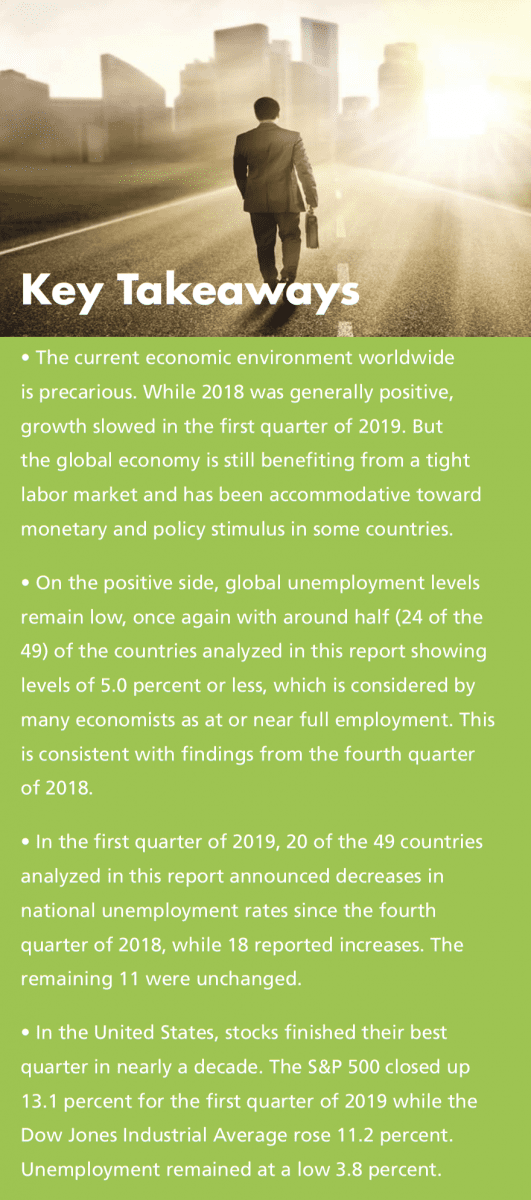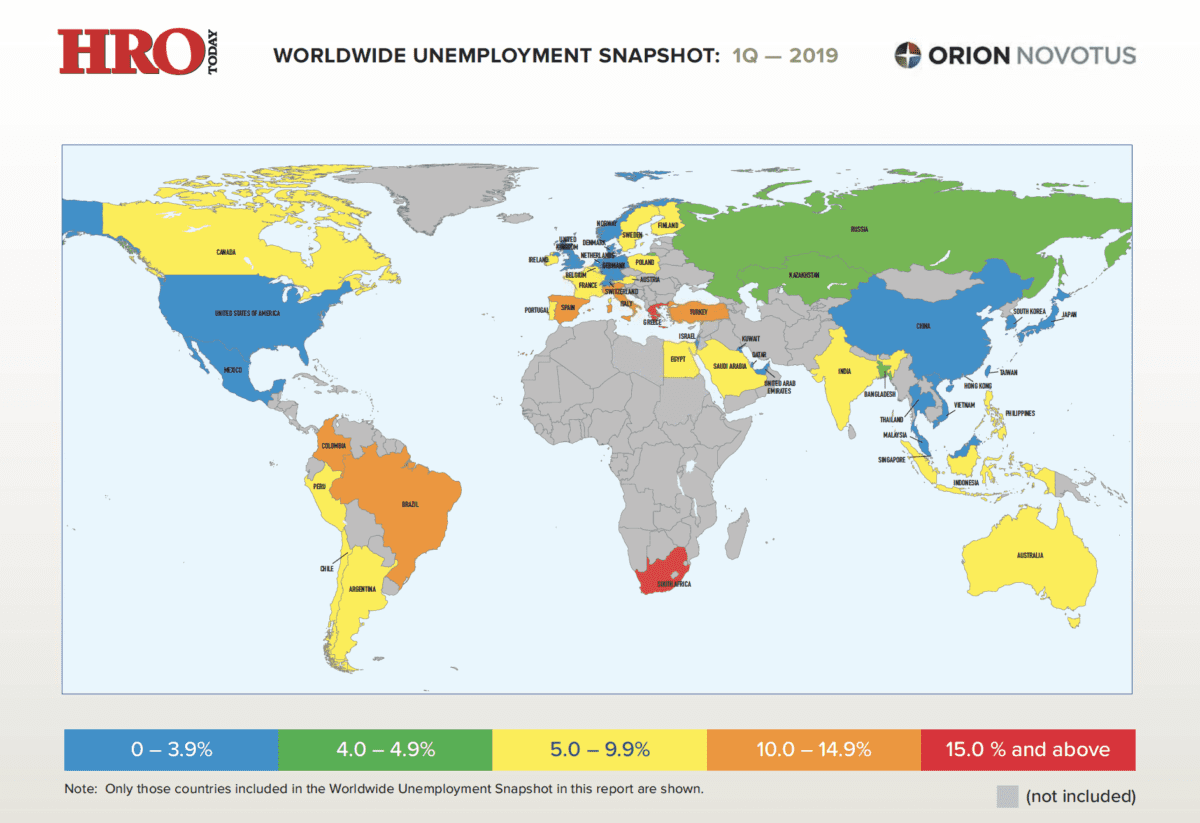Organizations are faced with a precarious worldwide economic environment and tight labor market in the first quarter of 2019.
By Larry Basinait
Coming off a strong year in 2018 where unemployment continued to fall in many countries, global growth in the first quarter of 2019 declined. The International Monetary Fund cut its outlook for global growth to 3.3 percent this year, the lowest since the financial crisis of 2009. A range of threats are menacing the global economy, including the possible collapse of negotiations between the U.S. and China to end their trade war and the departure of Britain from the European Union without a transition agreement.
But despite concerns about many economies, global unemployment is forecasted to fall from 5.0 percent in 2018 to 4.9 percent in 2019, as high-income countries have largely seen a decrease in their unemployment rates. An interesting trend in the global workforce is the large portion (61 percent) of employees reportedly engaging in contingent employment.
United States and Canada
The U.S. has largely seen a continuing tight labor market as the unemployment rate hovers below 4.0 percent. While consumer optimism has stayed relatively high over the past few months, it has tapered off recently as the government shutdown bled into the first quarter of the year. According to the Bureau of Economic Analysis, GDP grew by 3.2 percent in the first quarter of the year.
In March, the U.S. unemployment rate was 3.8 percent, which marks the fifth consecutive quarter with an unemployment rate of 4.0 or less. Historically, unemployment rates at 5.0 percent or just below are considered by many economists to be at or near full employment. U.S. stocks finished their best quarter in nearly a decade, as several clouds hanging over the financial markets at the end of 2018 dissipated enough to prompt a strong rebound for most shares.
The Canadian unemployment rate increased by 0.2 percent in the first quarter even as private sector job creation hit 300,000 jobs over the past six months, which amasses to the most in any six-month period on record. Real GDP is estimated to expand at an annual rate of 1.6 percent in 2019 even as talks of a recession have increased, though rising oil prices have helped keep the economy afloat.
Asia-Pacific (APAC)
According to an estimate for the region produced by FocusEconomics, the ESA region (East and South Asia) is expected to grow at 5.6 percent in 2019. Export-driven economies are expected to face headwinds this year from slow global growth and rising global trade protectionism, though accommodative monetary policy and Chinese fiscal policy support activity in the months ahead.

Japan has the second largest GDP in the APAC region at $5 trillion. The low Japanese unemployment rate in the first quarter of 2019 remained constant from the first quarter of 2018 at 2.5 percent, even though economic growth was weak. Economic forecasts for 2019 are a mixed bag. Front-loaded consumer spending ahead of the planned sales tax hike in October and the impact of the investment in the Tokyo 2020 Olympic Games could shore up economic growth this year. On the downside, the economy will feel the pinch of weak global demand, especially from China and Europe. Economists forecast GDP growth of only 0.8 percent in 2019.
Europe, the Middle East, and Africa (EMEA)
The EMEA region covers three continents and includes 116 different countries which vary greatly in GDP and population. Twenty-seven countries in EMEA are tracked in this quarterly analysis. Mixed results were seen in the quarter with unemployment rates in the overall EMEA region declining year-over-year in 14 of the 27 examined countries. The biggest decline in the unemployment rate was seen in Austria, where the unemployment rate fell by 1.3 percentage points for the quarter while Egypt saw the biggest decline for the year, down 2.5 percent. Conversely, Turkey and Finland reported the largest increase, with unemployment up over 1.5 percentage points for both, to 14.7 percent and 7.0 percent, respectively.
In the first quarter of 2019, the Eurozone economy grew by a tepid 1.2 percent, according to FocusEconomics. A combination of a weak manufacturing sector along with political turmoil and rising protectionism have pushed down consumer sentiment to a two-year low. Despite the bleak economic news surrounding the Eurozone, retail sales jumped in the month of January as household spending helped boost sales.
Germany has the third largest population in the region at 82.9 million, but by far the largest GDP ($4 trillion) in this region. If Germany struggles, the results keenly impact the entire region. In the first quarter of 2019, the robust service sector helped steer the German economy out of a recession even as most economic indicators were mixed throughout the quarter. During the quarter, the unemployment rate dropped from 3.5 percent in the first quarter of 2018 to 3.2 percent in the first quarter of 2019.
Latin America
The Latin American economy should improve in 2019 as the region is forecast to experience a 1.9 percent GDP growth for the year, driven by Brazil. Growth is expected to rise at 2.5 percent in 2020, though political risk, predominantly in Argentina, and the fiscal state of other governments remain a concern within the region.
At the end of 2018, Latin America’s largest economy, Brazil, reported its lowest unemployment rate in 2.5 years at 11.6 percent. However, that has proven short term, as there’s been an uptick in the unemployment rate to 12.7 percent in the first quarter of 2019, which in turn eroded consumer confidence to a six-month low. According to the CEIC, the rise in unemployment has been largely due to a decline in consumer spending, which makes up about two-thirds of Brazil’s economic output, along with a fall in industrial production.
Mexico is the second-largest country in the region, both by GDP and population. The Mexican economy continued to lose steam in the first quarter of the year. Industrial output and manufacturing both slid on top of flagging oil production despite strong wage growth and higher consumer confidence. Due to the recent weak economic numbers, there has been a 0.3 percent increase in the unemployment rate from the first quarter of 2018, which now stands at 3.2 percent.
Editor’s note: To view the entire report, click here. This research is sponsored by HRO Today and Orion Novotus, an Orion Talent company.















